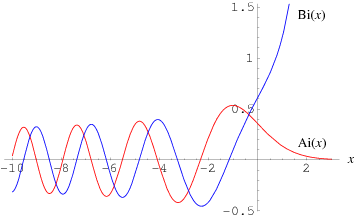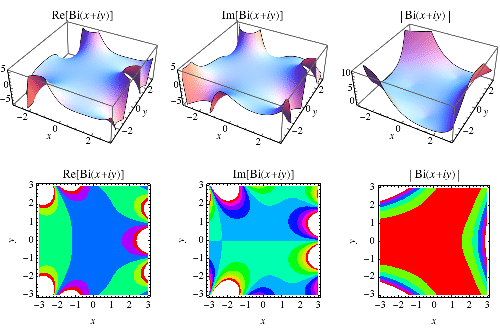


 تاريخ الرياضيات
تاريخ الرياضيات
 الرياضيات في الحضارات المختلفة
الرياضيات في الحضارات المختلفة 
 الرياضيات المتقطعة
الرياضيات المتقطعة
 الجبر
الجبر
 الهندسة
الهندسة 
 المعادلات التفاضلية و التكاملية
المعادلات التفاضلية و التكاملية 
 التحليل
التحليل
 علماء الرياضيات
علماء الرياضيات |
Read More
Date: 17-11-2018
Date: 18-10-2018
Date: 16-12-2018
|
 ,
,  ,
,  , and
, and  . Of these,
. Of these,  and
and  are by far the most common, with
are by far the most common, with  and
and  being encountered much less frequently. Airy functions commonly appear in physics, especially in optics, quantum mechanics, electromagnetics, and radiative transfer.
being encountered much less frequently. Airy functions commonly appear in physics, especially in optics, quantum mechanics, electromagnetics, and radiative transfer.
 and
and  are entire functions.
are entire functions.
A generalization of the Airy function was constructed by Hardy.

The Airy function  and
and  functions are plotted above along the real axis.
functions are plotted above along the real axis.
The  and
and  functions are defined as the two linearly independent solutions to
functions are defined as the two linearly independent solutions to
 |
(1) |
(Abramowitz and Stegun 1972, pp. 446-447; illustrated above), written in the form
 |
(2) |
where
 |
 |
 |
(3) |
 |
 |
 |
(4) |
where  is a confluent hypergeometric limit function. These functions are implemented in the Wolfram Language as AiryAi[z] and AiryBi[z]. Their derivatives are implemented as AiryAiPrime[z] and AiryBiPrime[z].
is a confluent hypergeometric limit function. These functions are implemented in the Wolfram Language as AiryAi[z] and AiryBi[z]. Their derivatives are implemented as AiryAiPrime[z] and AiryBiPrime[z].
For the special case  , the functions can be written as
, the functions can be written as
 |
 |
![1/3sqrt(x)[I_(-1/3)(2/3x^(3/2))-I_(1/3)(2/3x^(3/2))]](http://mathworld.wolfram.com/images/equations/AiryFunctions/Inline25.gif) |
(5) |
 |
 |
 |
(6) |
 |
 |
![sqrt(x/3)[I_(-1/3)(2/3x^(3/2))+I_(1/3)(2/3x^(3/2))],](http://mathworld.wolfram.com/images/equations/AiryFunctions/Inline31.gif) |
(7) |
where  is a modified Bessel function of the first kind and
is a modified Bessel function of the first kind and  is a modified Bessel function of the second kind.
is a modified Bessel function of the second kind.
 |
Plots of  in the complex plane are illustrated above.
in the complex plane are illustrated above.
 |
Similarly, plots of  appear above.
appear above.
The Airy  function is given by the integral
function is given by the integral
 |
(8) |
and the series
 |
 |
![1/(3^(2/3)pi)sum_(n=0)^(infty)(Gamma(1/3(n+1)))/(n!)(3^(1/3)z)^nsin[(2(n+1)pi)/3]](http://mathworld.wolfram.com/images/equations/AiryFunctions/Inline39.gif) |
(9) |
 |
 |
![1/(3^(1/6)pi)sum_(n=0)^(infty)(Gamma(1/3(n+1)))/(n!)(3^(1/3)z)^n|sin[(2(n+1)pi)/3]|](http://mathworld.wolfram.com/images/equations/AiryFunctions/Inline42.gif) |
(10) |
(Banderier et al. 2000).
For  ,
,
 |
 |
 |
(11) |
 |
 |
 |
(12) |
where  is the gamma function. Similarly,
is the gamma function. Similarly,
 |
 |
 |
(13) |
 |
 |
 |
(14) |
The asymptotic series of  has a different form in different quadrants of the complex plane, a fact known as the stokes phenomenon.
has a different form in different quadrants of the complex plane, a fact known as the stokes phenomenon.

![]()

![]()
Functions related to the Airy functions have been defined as
 |
 |
 |
(15) |
 |
 |
![1/3Bi(z)+int_0^z[Ai(z)Bi(t)-Ai(t)Bi(z)]dt](http://mathworld.wolfram.com/images/equations/AiryFunctions/Inline63.gif) |
(16) |
 |
 |
 |
(17) |
 |
 |
 |
(18) |
 |
 |
![2/3Bi(z)+int_0^z[Ai(t)Bi(z)-Ai(z)Bi(t)]dt](http://mathworld.wolfram.com/images/equations/AiryFunctions/Inline72.gif) |
(19) |
 |
 |
 |
(20) |
where  is a generalized hypergeometric function.
is a generalized hypergeometric function.
Watson (1966, pp. 188-190) gives a slightly more general definition of the Airy function as the solution to the Airy differential equation
 |
(21) |
which is finite at the origin, where  denotes the derivative
denotes the derivative  ,
,  , and either sign is permitted. Call these solutions
, and either sign is permitted. Call these solutions  , then
, then
 |
(22) |
 |
 |
![1/3pisqrt(z/3)[J_(-1/3)((2z^(3/2))/(3^(3/2)))+J_(1/3)((2z^(3/2))/(3^(3/2)))]](http://mathworld.wolfram.com/images/equations/AiryFunctions/Inline83.gif) |
(23) |
 |
 |
![1/3pisqrt(z/3)[I_(-1/3)((2z^(3/2))/(3^(3/2)))-I_(1/3)((2z^(3/2))/(3^(3/2)))],](http://mathworld.wolfram.com/images/equations/AiryFunctions/Inline86.gif) |
(24) |
where  is a Bessel function of the first kind. Using the identity
is a Bessel function of the first kind. Using the identity
 |
(25) |
where  is a modified Bessel function of the second kind, the second case can be re-expressed
is a modified Bessel function of the second kind, the second case can be re-expressed
 |
 |
 |
(26) |
 |
 |
 |
(27) |
 |
 |
 |
(28) |
REFERENCES:
Abramowitz, M. and Stegun, I. A. (Eds.). "Airy Functions." §10.4 in Handbook of Mathematical Functions with Formulas, Graphs, and Mathematical Tables, 9th printing. New York: Dover, pp. 446-452, 1972.
Banderier, C.; Flajolet, P.; Schaeffer, G.; and Soria, M. "Planar Maps and Airy Phenomena." In Automata, Languages and Programming. Proceedings of the 27th International Colloquium (ICALP 2000) held at the University of Geneva, Geneva, July 9-15, 2000 (Ed. U. Montanari, J. D. P. Rolim, and E. Welzl). Berlin: Springer, pp. 388-402, 2000.
Press, W. H.; Flannery, B. P.; Teukolsky, S. A.; and Vetterling, W. T. "Bessel Functions of Fractional Order, Airy Functions, Spherical Bessel Functions." §6.7 in Numerical Recipes in FORTRAN: The Art of Scientific Computing, 2nd ed. Cambridge, England: Cambridge University Press, pp. 234-245, 1992.
Sloane, N. J. A. Sequences A096714 and A096715 in "The On-Line Encyclopedia of Integer Sequences."
Spanier, J. and Oldham, K. B. "The Airy Functions Ai( ) and Bi(
) and Bi( )." Ch. 56 in An Atlas of Functions. Washington, DC: Hemisphere, pp. 555-562, 1987.
)." Ch. 56 in An Atlas of Functions. Washington, DC: Hemisphere, pp. 555-562, 1987.
Watson, G. N. A Treatise on the Theory of Bessel Functions, 2nd ed. Cambridge, England: Cambridge University Press, 1966.



|
|
|
|
تفوقت في الاختبار على الجميع.. فاكهة "خارقة" في عالم التغذية
|
|
|
|
|
|
|
أمين عام أوبك: النفط الخام والغاز الطبيعي "هبة من الله"
|
|
|
|
|
|
|
قسم شؤون المعارف ينظم دورة عن آليات عمل الفهارس الفنية للموسوعات والكتب لملاكاته
|
|
|